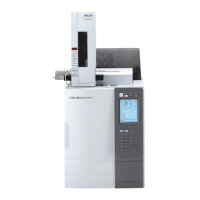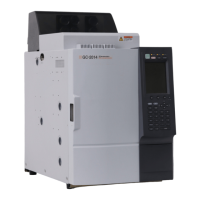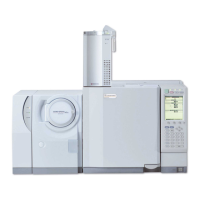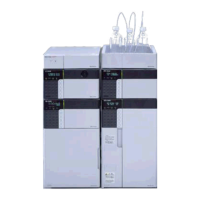13 Detector
13.2 Hydrogen flame ionization detector (FID)
152
GC-2010 Plus
Select the optimum value in accordance with the peak half width. (Refer to “13.4 Filter
Signal Time Constant”.)
SIGNAL OUTPUT PORT
Selection: Off/Ch1/Ch2/Ch3/Ch4, Default: (Channel is automatically assigned.)
Select the digital and analog signals output channels. Four channels are available.
However, for analog output, only Ch1 and Ch2 are available.
BACKGROUND SIG. SAVE
Selection: Off/Buff 1/Buff 2, Default: Off
Background baseline signals can be saved for the purpose of background subtraction.
BACKGROUND SIG COMP.
Selection: Off/Buff 1/Buff 2, Default: Off
Subtracts the saved background signal baseline from the actual baseline. This produces
a stable baseline despite considerable baseline fluctuations
DET SIG SUBTRACTION
Selection: Off/DET# 1/DET# 2/DET# 3/DET# 4, Default: Off
Subtracts the detector signal of one detector from the signal of another detector. This
function is mainly used in a dual column flow line to subtract the data acquired without
an injection from the data acquired with an injection. The background signal is elimi-
nated.
For the details on “SIGNAL OUTPUT PORT”, “BACKGROUND SIG. SAVE”, “BACKGROUND
SIG COMP.” and “DET SIG SUBTRACTION”, refer to “13.5 Setting the Output Signals”.
SIGNAL RANGE
Selection: ×1/×10
-1
/×10
-2
/×10
-3
/×10
-4
, Default: /×10
-1
Multiplies the analog signal by the coefficient “10
-x
” for a linear analog signal type.
If the signal intensity of a peak is beyond the input range of the data processing unit, for
example, change the setting from “×1” to “×10
-1
”, from “×10
-2
” to “×10
-3
”. If the peak is
too small, for example, change the setting from “×10
-1
” to “×1”, from “×10
-3
” to “×10
-2
”. In
case of the digital signal, the signal is always output with “×1”.
SIGNAL ATTENUATION
Selection: ×1/×2
-1
/×2
-2
/×2
-3
/×2
-4
, Default: /×2
-1
Multiplies the analog signal by the coefficient “2
-x
” for a wide analog signal type.
If the signal intensity of a peak is beyond the input range of the data processing unit, for
example, change the setting from “×1” to “×2
-1
”, from “×2
-2
” to “×2
-3
”. If the peak is too
small, for example, change the setting from “×2
-1
” to “×1”, from “×2
-3
” to “×2
-2
”. In case of
the digital signal, the signal is always output with “×1”.
ANALOG SIGNAL TYPE
Selection: Linear/Wide, Default: Linear
Set this item when the GC is connected to a Chromatopac in analog format.
Wide ... Select wide when connecting the GC to the C-R8A/C-R7A/C-R7A plus with
the signal cable in the standard accessories.
The signal, raised to the 1/2(one-half) power, is output from the GC; then, the
signal received by the Chromatopac is squared.
When connecting the GC to a C-R8A/C-R7A/C-R7A plus for the first time, or
replacing the Chromatopac, set the detector signal output to “Off” and perform
the wide range calibration. (For the wide range calibration procedure, refer to
“2.7 Connecting external device cables”.)
Linear ... Select linear when connecting the GC to any Chromatopac other than the C-
R8A/C-R7A/CR-7A plus. When connecting the GC to a C-R8A/C-R7A/C-R7A
plus and setting the “ANALOG SIGNAL TYPE” to “Linear”, the optional signal
cable (linear, P/N 221-47251-92) is required.
In case of “Linear”, the Chromatopac does not need the wide range calibra-
tion.

